ORDER
Charadriiformes
FAMILY
Burhinidae
GENUS & SPECIES
key features
A nocturnal bird, its loud, melodious calls are heard after sunset and throughout the night Coloration helps both the chick and adult blend in amazingly well with their heath homeland Enlarged heel joint, commonly mistaken for a knee, has led to its common name, “thick-knee”
where in the world?
Found in Europe and northern Africa; also in southwest Asia, including India, Myanmar and the Arabian Peninsula
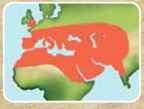
LIFECYCLE
The stone curlew spends its life well hidden: egg, chick and adult are all effectively cloaked from most daytime intruders with camouflaging colors.
HABITAT
Open country — far from the noise of civilization — attracts the stone curlew.The bird is found across Europe and Southwest Asia in sandy or stony grasslands or heaths. The stone curlew prefers dry areas, unlike the other members of its family, Burhinidae. The stone curlew is also the only migratory bird in this family. In the northern reaches of its range, flocks form in October and migrate south to northern Africa, returning north again in March. Other stone curlews remain in their home year-round.
Cryptic curlew
A motionless curlew blends with its surroundings.
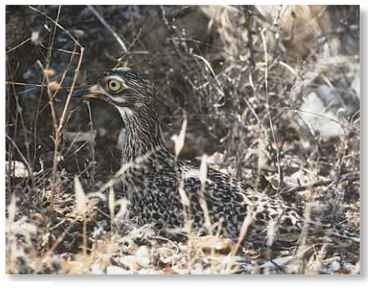
CONSERVATION
Though the stone curlew is currently not endangered, its numbers have been affected by habitat destruction. Open heath areas, needed for nesting, are disappearing throughout Europe as housing developments replace them.The habitat disturbance caused by construction forces the stone curlew to leave surrounding areas as well, since the bird prefers to stay far away from any kind of human activity.
BREEDING
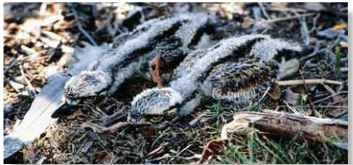
A Stay down Flattened chicks are difficult to detect.
The stone curlew mates for life, and pairs usually return each year to the same nesting territory. During courtship, the two birds stand together, their necks arched and bills pointed to the ground.They touch bills and bow, and then often run around excitedly The nest is a mere scrape in the ground, near vegetation but not actually among the plants. Stones and rabbit droppings, used for padding, may be added to the hollow.The female lays two buff eggs; their dark-brown spots camouflage them well. Both parents incubate the eggs and care for the young, which look like fluffy bundles of feathers on stilts. The chicks walk at 2 days old and quickly learn how to find food themselves; they fledge by 5 weeks of age.
Keep it simple
The curlew’s nest is just a slight depression.
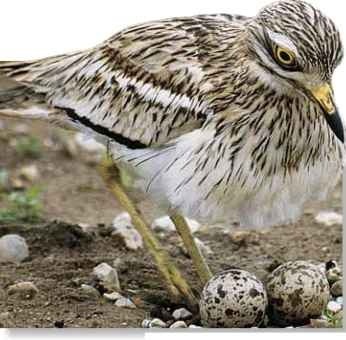
BEHAVIOR
The stone curlew is more often heard than seen. Its nighttime calls include a loud, melodious curlee, hence its common name. The stone curlew’s muted colors and patterns provide excellent camouflage while it rests during the day.The bird often squats on its tarsi; its streaked-brown upperparts blend with the ground. It will often remain completely still when approached. But, depending on the threat and whether eggs or chicks are in danger, the bird will also stand, spread out its wings and erect its feathers.
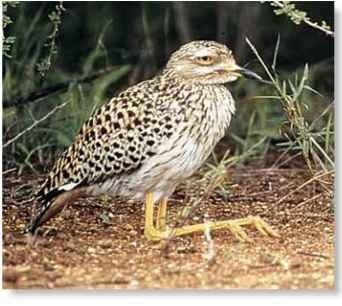
A PLAN FOR DISTRACTION
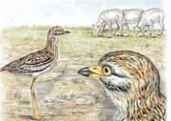
Warning…
A female is incubating her eggs when the male sights approaching sheep and signals her with an alarm call and threat posture.
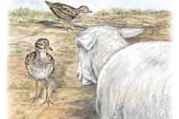
Confronting…
The male approaches one of the sheep in order to attract its attention, while the female secretly leaves the nest.
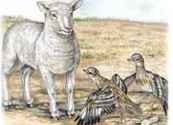
Diverting…
Both parents attempt to redirect the sheep’s attention from the nest by performing an elaborate distraction display.

Departing
The startled sheep walks away. The male follows, continuing to intimidate the sheep; the female sneaks back to the nest.
FOOD & FEEDING
At sunset, the stone curlew rises from its daytime rest to begin an evening of searching, with its piercing, yellow eyes, for insects, worms, snails, lizards, frogs and rodents. The bird also eats young chicks, especially pheasants and partridges. The stone curlew strides purposefully along, almost trotting, and stops frequently to probe the soil with its short, straight bill. Its diet is similar to that of day-active (diurnal) birds but, with the other birds asleep, the stone curlew has little competition.

A probing pair
Two stone curlews search the grassland floor for food, probing for worms and insects.
Stone curlew chicks will attain adult plumage within 3 months of birth.
The stone curlew is very confident in its ability to stay unseen on the ground; even when touched by humans, it often remains perfectly motionless.
If danger threatens before the chicks can run, the parents pick them up and carry them to a new hideaway.
PROFILE
Stone Curlew
The stone curlew’s nighttime feeding expeditions are aided by hawklike eyes, strong feet and fluid, silent flight.
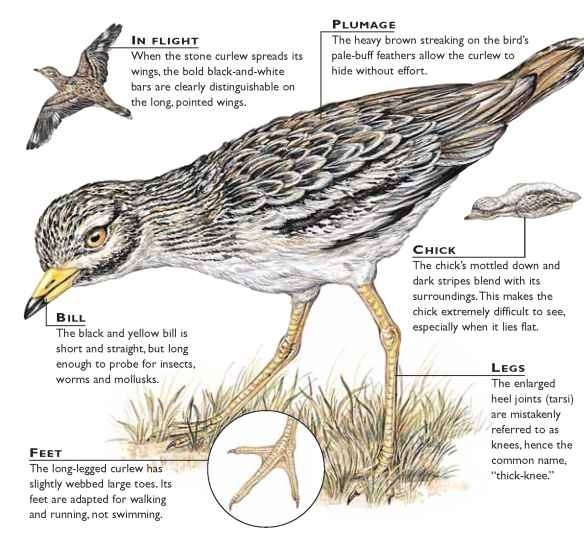
CREATURE COMPARISONS
Measuring up to 23.5″ long, the bush stone curlew (Burhinus grallarius), also called the bush thick-knee, is much larger than the stone curlew. Easily distinguished by its black eye stripe and streaking, the bush thick-knee’s color patterns still blend well with its surroundings.The bush thick-knee is more of a wader than its cousin, and lives along reefs, beaches and coastal mud flats, as well as grassy woodland in Australia. Like the stone curlew, it prefers to feed at night, but eats mainly mollusks and crustaceans found near the waterline.
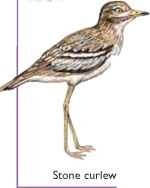
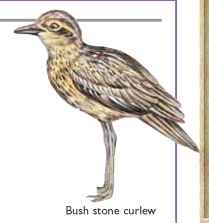
| vital | - | |
| statistics | ||
| Weight | 13-16 oz. | |
| Length | 16-17″ | |
| Sexual Maturity | 2-3 years | |
| Breeding Season | April-July | |
| Number of Eggs | 2 | |
| Incubation Period | 24-27 days | |
| Fledging Period | 36-42 days | |
| Breeding Interval | Sometimes 2 broods per year | |
| Typical Diet | Insects and occasionally small vertebrates |
|
| Lifespan | Up to 16 years | |
Related species
• The stone curlew is one of 7 species in the genus Burhinus. Other members include the spotted thick-knee, B. capensis, and dikkop, B. vermiculatus. The family Burhinidae includes both Burhinus and the genus Esacus, which contains the beach stone curlew, E. magnirostris. These birds join gulls, terns and auks in the order Charadriiformes, which contains over 300 species.

